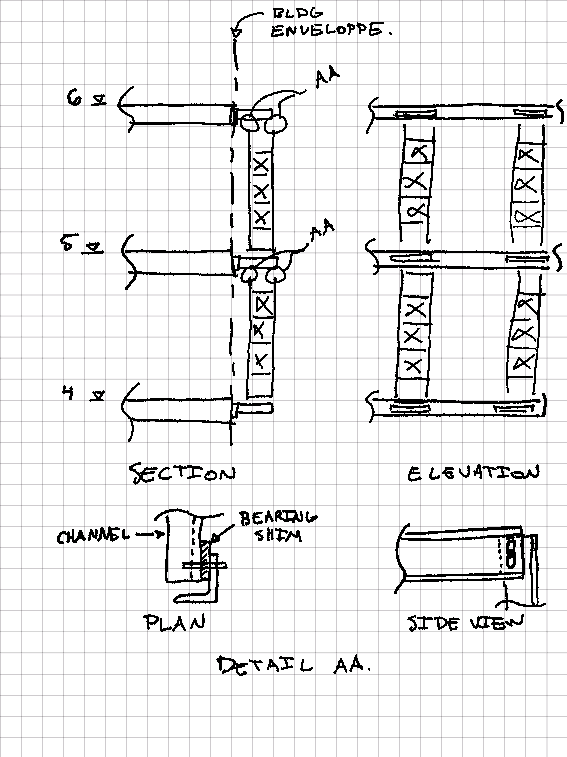canadiancastor
Structural
I'm working on a steel infill truss that will be used to attach thin natural stone panels to a concrete building. The building is 35 stories high with cantilevered concrete slabs. The infill structure is a "3D" box element that is 2' wide by 1' deep and will be suspended outside of the building envelope (see attached sketch). My plans is to cantilever steel channels off the slab face (using channel anchors or concrete screws) and attach the truss to these channels. The truss itself will be composed of steel angles, from a preliminary analysis, around L2x2x3/16. I plan on transferring 100% of the gravity load to the bottom slab (at each story), while lateral loads will be transferred at the top and bottom of each truss. I'm thinking of having the whole truss galvanized once fabricated.
My question is about the transfer of lateral loads at the top of the truss. I want to avoid transferring vertical loads, for a couple of reasons:
[ol 1]
[li]I don't want my structure to support the concrete slab and its loads[/li]
[li]I want to permit thermal expansion to some degree[/li]
[li]Some room for on site adjustment, if possible, without welding[/li]
[/ol]
I'm trying to find an easy way to create connection that transfers loads in both lateral directions without transferring gravity loads. I came up with the slotted connection shown in my sketch. I know slotted connections are used all the time for light gauge steel walls at the top rail. Is there an issue with the bolt moving up and down in the slot? Like screeching noise? Wearing or loosening of the bolt? I guess I'm not used to having things moving around in my designs.
This will be my first time on this type of project, any extra tips would be appreciated. I have mandated an external firm for the design and drafting of the thin granite panels and the substructure (back face anchors to aluminum clips).

My question is about the transfer of lateral loads at the top of the truss. I want to avoid transferring vertical loads, for a couple of reasons:
[ol 1]
[li]I don't want my structure to support the concrete slab and its loads[/li]
[li]I want to permit thermal expansion to some degree[/li]
[li]Some room for on site adjustment, if possible, without welding[/li]
[/ol]
I'm trying to find an easy way to create connection that transfers loads in both lateral directions without transferring gravity loads. I came up with the slotted connection shown in my sketch. I know slotted connections are used all the time for light gauge steel walls at the top rail. Is there an issue with the bolt moving up and down in the slot? Like screeching noise? Wearing or loosening of the bolt? I guess I'm not used to having things moving around in my designs.
This will be my first time on this type of project, any extra tips would be appreciated. I have mandated an external firm for the design and drafting of the thin granite panels and the substructure (back face anchors to aluminum clips).

